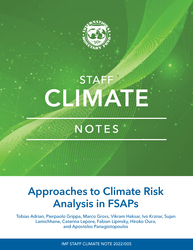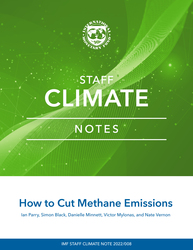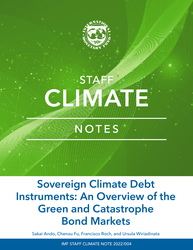
Approaches to Climate Risk Analysis in FSAPs
This Staff Climate Note provides a primer on complex climate scenario design issues and discusses methodologies to analyze both transition and physical risk.
READ MORE...
Volume/Issue:
Volume 2022
Issue 005
Publication date: July 2022
ISBN: 9798400212895
$5.00
Add to Cart by clicking price of the language and format you'd like to purchase
Available Languages and Formats
| English |
Prices in red indicate formats that are not yet available but are forthcoming.
Topics covered in this book
This title contains information about the following subjects.
Click on a subject if you would like to see other titles with the same subjects.
Finance , Economics- Macroeconomics , Taxation - General , Economics / General , Environmental Economics , climate change , physical risk , transition risk , risk analysis , stress testing , Financial Sector Assessment Program , IMF staff Climate note , climate risk analysis , banking sector stability risk , IMF staff Climate Note 2022/005 , Carbon tax , Global
Summary
Climate change presents risks and opportunities for the real economies and financial sectors of the IMF’s global membership. Understanding the risks is key to prepare for a successful transition to a lower carbon global economy. This will unlock the many opportunities for technological progress and structural transformation along the path that financial sectors around the world will need to adapt to and support. This note lays out the IMF staff’s emerging approach to assessing the impact of climate change on banking sector stability risks conducted in the context of the IMF’s Financial Sector Assessment Program (FSAP). The note starts with a primer on climate change risk, both transition and physical, explaining some of the technical terms and concepts used in this work. It explains the approach to standard risk analysis in FSAPs, and how this would be modified in broad terms to incorporate climate risk. The note then discusses different approaches to the analysis of physical versus transition risk, their implications for the macro-economy and across sectors in the real economy and different geographies, and how all these effects map into the banking sector. The note illustrates concepts with examples of applications from recent FSAPs and takes note of the many challenges confronting this work, including data gaps and uncertainty regarding climate projections and long simulation horizons in conducting the climate risk analysis. As such the note is focused on methods that IMF staff are deploying to raise awareness of the risks, and adaptation needs, including need for banks to develop tools to manage climate risks and for financial sector supervisory authorities to adequately supervise this risk.
Copyright © 2010 - 2025
Powered by:
AIDC



